Comprehensive Overview of Five Benefits in GLSCM: A Detailed Analysis
VerifiedAdded on 2021/05/30
|9
|2017
|32
Report
AI Summary
This report delves into the benefits of Global Logistics and Supply Chain Management (GLSCM), highlighting five key themes. Firstly, it emphasizes the use of Information Technology (IT) as a crucial enabler for businesses, facilitating real-time inventory management and integration. Secondly, it explores the Just-in-Time (JIT) system as a strategy to minimize inventory costs and increase efficiency. Thirdly, the report discusses the application of Six-Sigma methodologies to reduce defects and optimize the supply chain. Fourthly, it examines the increasing use of Enterprise Resource Planning (ERP) systems to integrate supply chain functions with other organizational aspects. Finally, it underscores the importance of Total Quality Management (TQM) in ensuring the final output of an effective supply chain. The report provides examples of companies like Zara, Ranbaxy, Toyota, and Walmart to illustrate these concepts, supported by references to various academic sources.

Running head: SUPPLY CHAIN
Supply Chain
Student’s name
Name of the Institute
Supply Chain
Student’s name
Name of the Institute
Paraphrase This Document
Need a fresh take? Get an instant paraphrase of this document with our AI Paraphraser
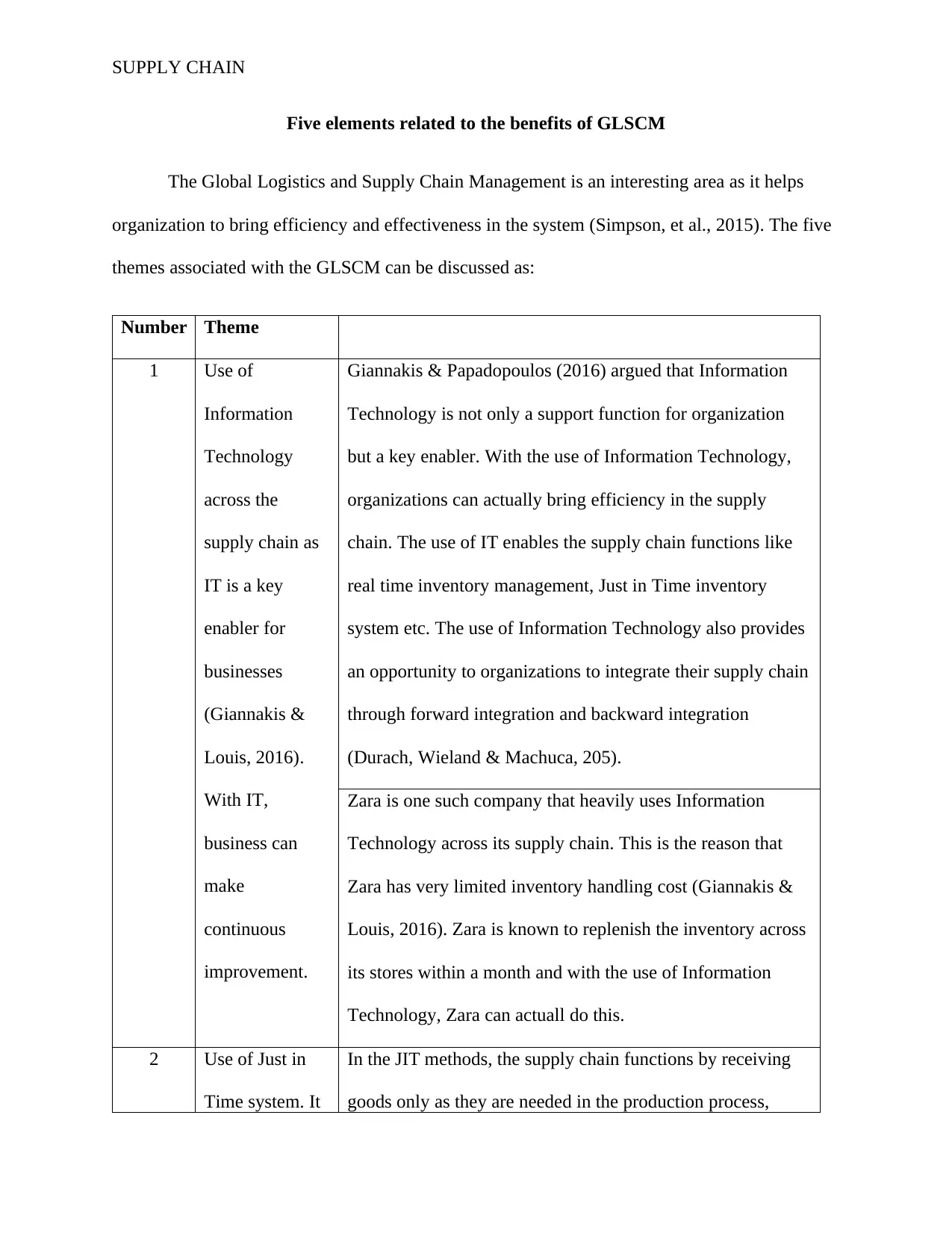
SUPPLY CHAIN
Five elements related to the benefits of GLSCM
The Global Logistics and Supply Chain Management is an interesting area as it helps
organization to bring efficiency and effectiveness in the system (Simpson, et al., 2015). The five
themes associated with the GLSCM can be discussed as:
Number Theme
1 Use of
Information
Technology
across the
supply chain as
IT is a key
enabler for
businesses
(Giannakis &
Louis, 2016).
With IT,
business can
make
continuous
improvement.
Giannakis & Papadopoulos (2016) argued that Information
Technology is not only a support function for organization
but a key enabler. With the use of Information Technology,
organizations can actually bring efficiency in the supply
chain. The use of IT enables the supply chain functions like
real time inventory management, Just in Time inventory
system etc. The use of Information Technology also provides
an opportunity to organizations to integrate their supply chain
through forward integration and backward integration
(Durach, Wieland & Machuca, 205).
Zara is one such company that heavily uses Information
Technology across its supply chain. This is the reason that
Zara has very limited inventory handling cost (Giannakis &
Louis, 2016). Zara is known to replenish the inventory across
its stores within a month and with the use of Information
Technology, Zara can actuall do this.
2 Use of Just in
Time system. It
In the JIT methods, the supply chain functions by receiving
goods only as they are needed in the production process,
Five elements related to the benefits of GLSCM
The Global Logistics and Supply Chain Management is an interesting area as it helps
organization to bring efficiency and effectiveness in the system (Simpson, et al., 2015). The five
themes associated with the GLSCM can be discussed as:
Number Theme
1 Use of
Information
Technology
across the
supply chain as
IT is a key
enabler for
businesses
(Giannakis &
Louis, 2016).
With IT,
business can
make
continuous
improvement.
Giannakis & Papadopoulos (2016) argued that Information
Technology is not only a support function for organization
but a key enabler. With the use of Information Technology,
organizations can actually bring efficiency in the supply
chain. The use of IT enables the supply chain functions like
real time inventory management, Just in Time inventory
system etc. The use of Information Technology also provides
an opportunity to organizations to integrate their supply chain
through forward integration and backward integration
(Durach, Wieland & Machuca, 205).
Zara is one such company that heavily uses Information
Technology across its supply chain. This is the reason that
Zara has very limited inventory handling cost (Giannakis &
Louis, 2016). Zara is known to replenish the inventory across
its stores within a month and with the use of Information
Technology, Zara can actuall do this.
2 Use of Just in
Time system. It
In the JIT methods, the supply chain functions by receiving
goods only as they are needed in the production process,
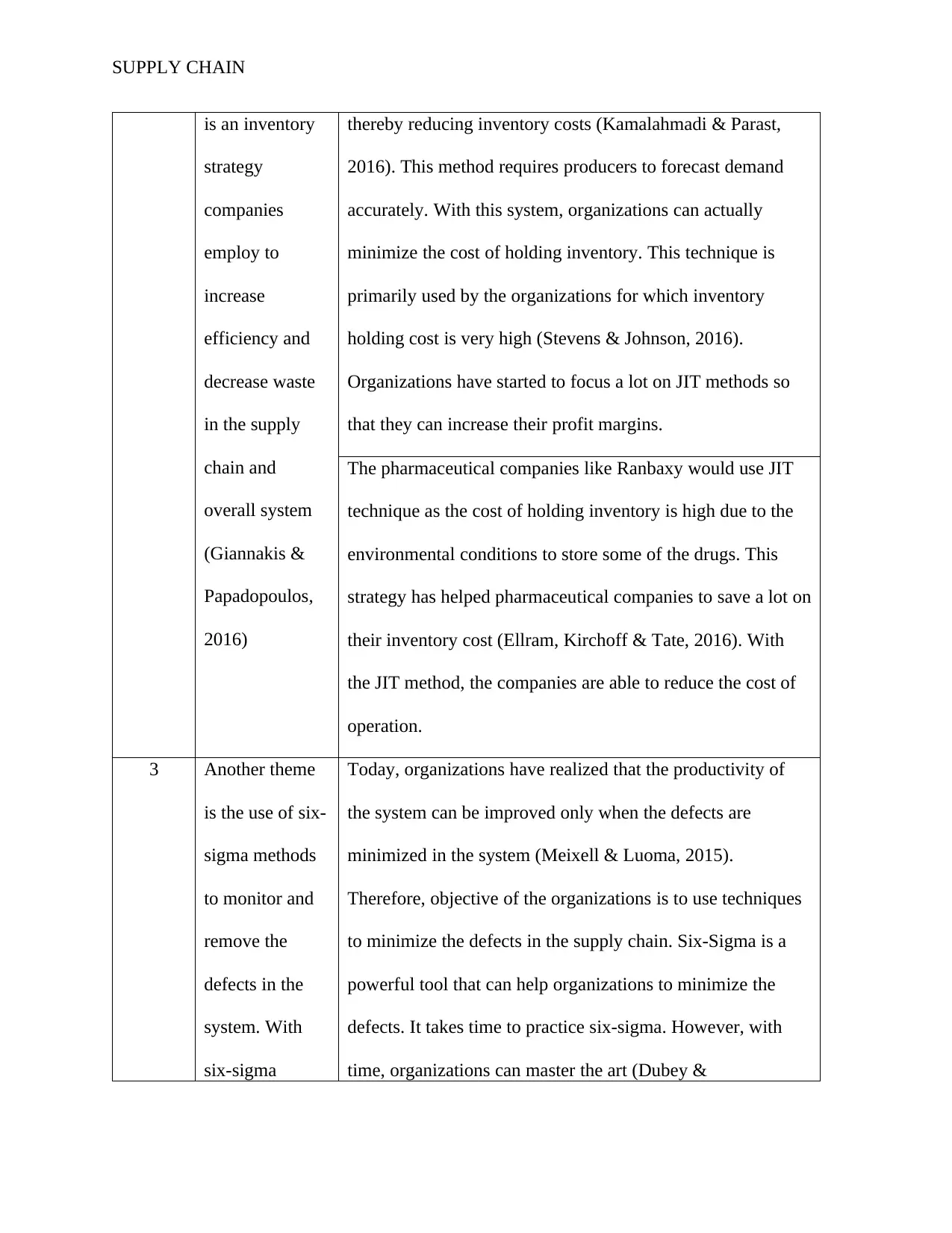
SUPPLY CHAIN
is an inventory
strategy
companies
employ to
increase
efficiency and
decrease waste
in the supply
chain and
overall system
(Giannakis &
Papadopoulos,
2016)
thereby reducing inventory costs (Kamalahmadi & Parast,
2016). This method requires producers to forecast demand
accurately. With this system, organizations can actually
minimize the cost of holding inventory. This technique is
primarily used by the organizations for which inventory
holding cost is very high (Stevens & Johnson, 2016).
Organizations have started to focus a lot on JIT methods so
that they can increase their profit margins.
The pharmaceutical companies like Ranbaxy would use JIT
technique as the cost of holding inventory is high due to the
environmental conditions to store some of the drugs. This
strategy has helped pharmaceutical companies to save a lot on
their inventory cost (Ellram, Kirchoff & Tate, 2016). With
the JIT method, the companies are able to reduce the cost of
operation.
3 Another theme
is the use of six-
sigma methods
to monitor and
remove the
defects in the
system. With
six-sigma
Today, organizations have realized that the productivity of
the system can be improved only when the defects are
minimized in the system (Meixell & Luoma, 2015).
Therefore, objective of the organizations is to use techniques
to minimize the defects in the supply chain. Six-Sigma is a
powerful tool that can help organizations to minimize the
defects. It takes time to practice six-sigma. However, with
time, organizations can master the art (Dubey &
is an inventory
strategy
companies
employ to
increase
efficiency and
decrease waste
in the supply
chain and
overall system
(Giannakis &
Papadopoulos,
2016)
thereby reducing inventory costs (Kamalahmadi & Parast,
2016). This method requires producers to forecast demand
accurately. With this system, organizations can actually
minimize the cost of holding inventory. This technique is
primarily used by the organizations for which inventory
holding cost is very high (Stevens & Johnson, 2016).
Organizations have started to focus a lot on JIT methods so
that they can increase their profit margins.
The pharmaceutical companies like Ranbaxy would use JIT
technique as the cost of holding inventory is high due to the
environmental conditions to store some of the drugs. This
strategy has helped pharmaceutical companies to save a lot on
their inventory cost (Ellram, Kirchoff & Tate, 2016). With
the JIT method, the companies are able to reduce the cost of
operation.
3 Another theme
is the use of six-
sigma methods
to monitor and
remove the
defects in the
system. With
six-sigma
Today, organizations have realized that the productivity of
the system can be improved only when the defects are
minimized in the system (Meixell & Luoma, 2015).
Therefore, objective of the organizations is to use techniques
to minimize the defects in the supply chain. Six-Sigma is a
powerful tool that can help organizations to minimize the
defects. It takes time to practice six-sigma. However, with
time, organizations can master the art (Dubey &
⊘ This is a preview!⊘
Do you want full access?
Subscribe today to unlock all pages.

Trusted by 1+ million students worldwide
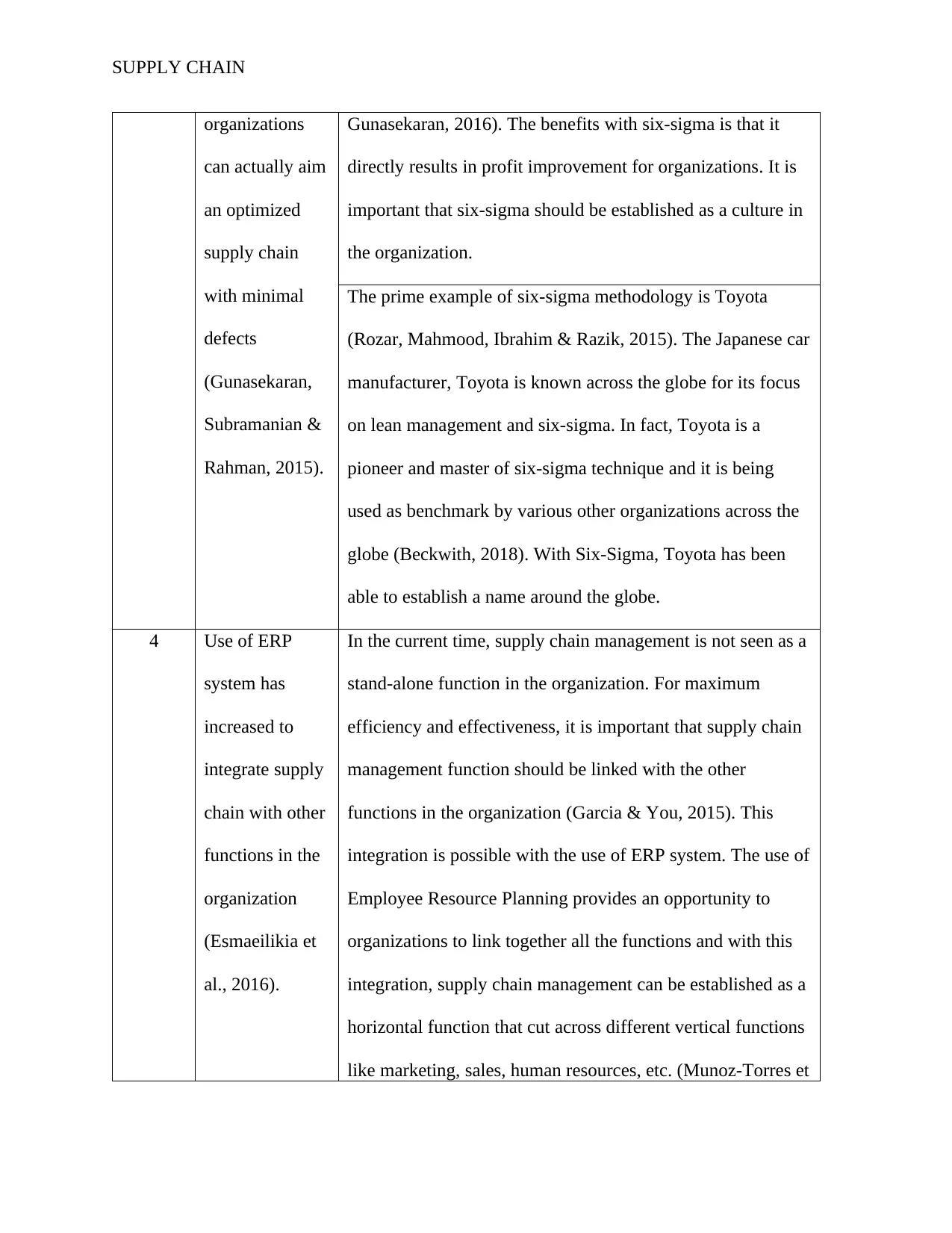
SUPPLY CHAIN
organizations
can actually aim
an optimized
supply chain
with minimal
defects
(Gunasekaran,
Subramanian &
Rahman, 2015).
Gunasekaran, 2016). The benefits with six-sigma is that it
directly results in profit improvement for organizations. It is
important that six-sigma should be established as a culture in
the organization.
The prime example of six-sigma methodology is Toyota
(Rozar, Mahmood, Ibrahim & Razik, 2015). The Japanese car
manufacturer, Toyota is known across the globe for its focus
on lean management and six-sigma. In fact, Toyota is a
pioneer and master of six-sigma technique and it is being
used as benchmark by various other organizations across the
globe (Beckwith, 2018). With Six-Sigma, Toyota has been
able to establish a name around the globe.
4 Use of ERP
system has
increased to
integrate supply
chain with other
functions in the
organization
(Esmaeilikia et
al., 2016).
In the current time, supply chain management is not seen as a
stand-alone function in the organization. For maximum
efficiency and effectiveness, it is important that supply chain
management function should be linked with the other
functions in the organization (Garcia & You, 2015). This
integration is possible with the use of ERP system. The use of
Employee Resource Planning provides an opportunity to
organizations to link together all the functions and with this
integration, supply chain management can be established as a
horizontal function that cut across different vertical functions
like marketing, sales, human resources, etc. (Munoz-Torres et
organizations
can actually aim
an optimized
supply chain
with minimal
defects
(Gunasekaran,
Subramanian &
Rahman, 2015).
Gunasekaran, 2016). The benefits with six-sigma is that it
directly results in profit improvement for organizations. It is
important that six-sigma should be established as a culture in
the organization.
The prime example of six-sigma methodology is Toyota
(Rozar, Mahmood, Ibrahim & Razik, 2015). The Japanese car
manufacturer, Toyota is known across the globe for its focus
on lean management and six-sigma. In fact, Toyota is a
pioneer and master of six-sigma technique and it is being
used as benchmark by various other organizations across the
globe (Beckwith, 2018). With Six-Sigma, Toyota has been
able to establish a name around the globe.
4 Use of ERP
system has
increased to
integrate supply
chain with other
functions in the
organization
(Esmaeilikia et
al., 2016).
In the current time, supply chain management is not seen as a
stand-alone function in the organization. For maximum
efficiency and effectiveness, it is important that supply chain
management function should be linked with the other
functions in the organization (Garcia & You, 2015). This
integration is possible with the use of ERP system. The use of
Employee Resource Planning provides an opportunity to
organizations to link together all the functions and with this
integration, supply chain management can be established as a
horizontal function that cut across different vertical functions
like marketing, sales, human resources, etc. (Munoz-Torres et
Paraphrase This Document
Need a fresh take? Get an instant paraphrase of this document with our AI Paraphraser
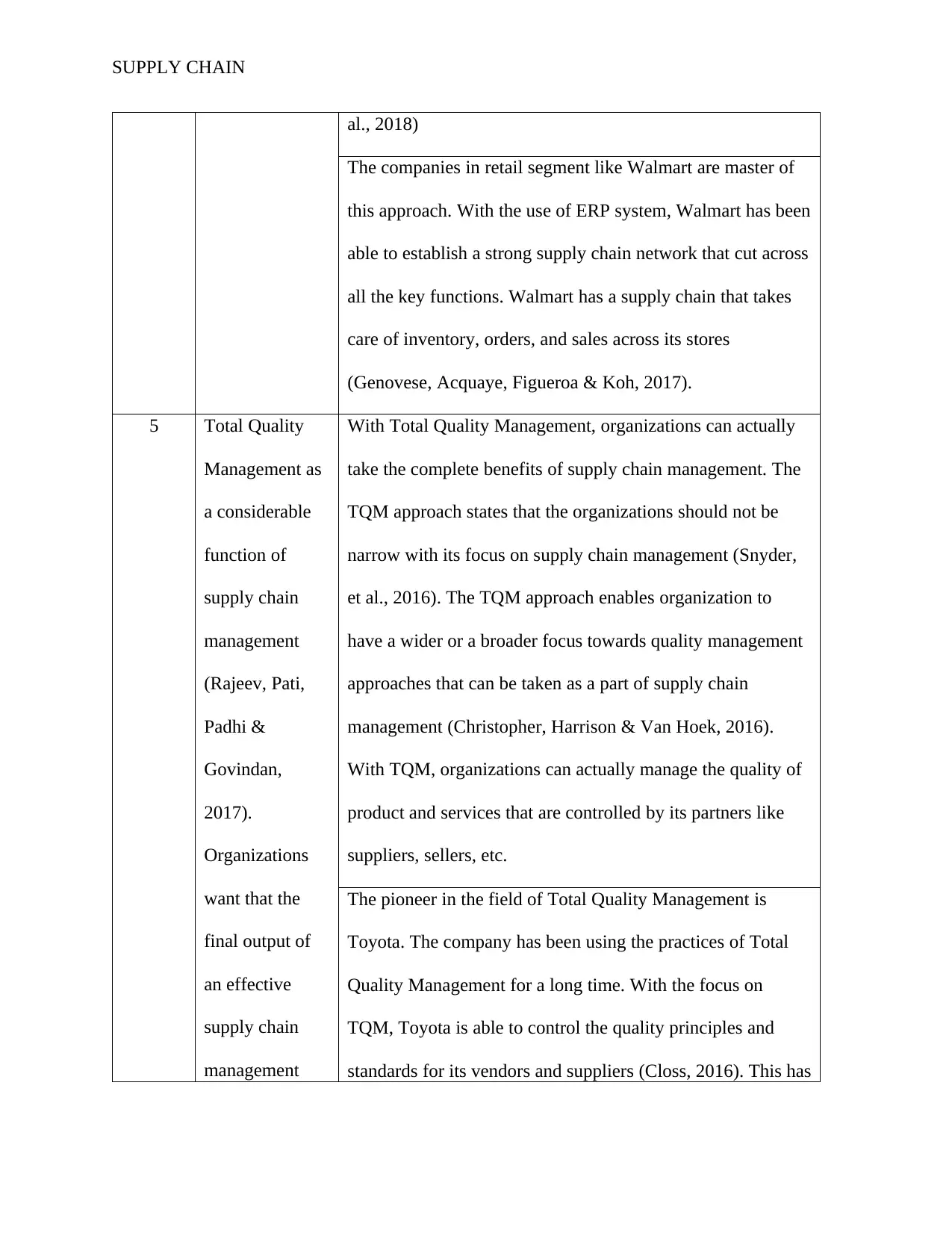
SUPPLY CHAIN
al., 2018)
The companies in retail segment like Walmart are master of
this approach. With the use of ERP system, Walmart has been
able to establish a strong supply chain network that cut across
all the key functions. Walmart has a supply chain that takes
care of inventory, orders, and sales across its stores
(Genovese, Acquaye, Figueroa & Koh, 2017).
5 Total Quality
Management as
a considerable
function of
supply chain
management
(Rajeev, Pati,
Padhi &
Govindan,
2017).
Organizations
want that the
final output of
an effective
supply chain
management
With Total Quality Management, organizations can actually
take the complete benefits of supply chain management. The
TQM approach states that the organizations should not be
narrow with its focus on supply chain management (Snyder,
et al., 2016). The TQM approach enables organization to
have a wider or a broader focus towards quality management
approaches that can be taken as a part of supply chain
management (Christopher, Harrison & Van Hoek, 2016).
With TQM, organizations can actually manage the quality of
product and services that are controlled by its partners like
suppliers, sellers, etc.
The pioneer in the field of Total Quality Management is
Toyota. The company has been using the practices of Total
Quality Management for a long time. With the focus on
TQM, Toyota is able to control the quality principles and
standards for its vendors and suppliers (Closs, 2016). This has
al., 2018)
The companies in retail segment like Walmart are master of
this approach. With the use of ERP system, Walmart has been
able to establish a strong supply chain network that cut across
all the key functions. Walmart has a supply chain that takes
care of inventory, orders, and sales across its stores
(Genovese, Acquaye, Figueroa & Koh, 2017).
5 Total Quality
Management as
a considerable
function of
supply chain
management
(Rajeev, Pati,
Padhi &
Govindan,
2017).
Organizations
want that the
final output of
an effective
supply chain
management
With Total Quality Management, organizations can actually
take the complete benefits of supply chain management. The
TQM approach states that the organizations should not be
narrow with its focus on supply chain management (Snyder,
et al., 2016). The TQM approach enables organization to
have a wider or a broader focus towards quality management
approaches that can be taken as a part of supply chain
management (Christopher, Harrison & Van Hoek, 2016).
With TQM, organizations can actually manage the quality of
product and services that are controlled by its partners like
suppliers, sellers, etc.
The pioneer in the field of Total Quality Management is
Toyota. The company has been using the practices of Total
Quality Management for a long time. With the focus on
TQM, Toyota is able to control the quality principles and
standards for its vendors and suppliers (Closs, 2016). This has
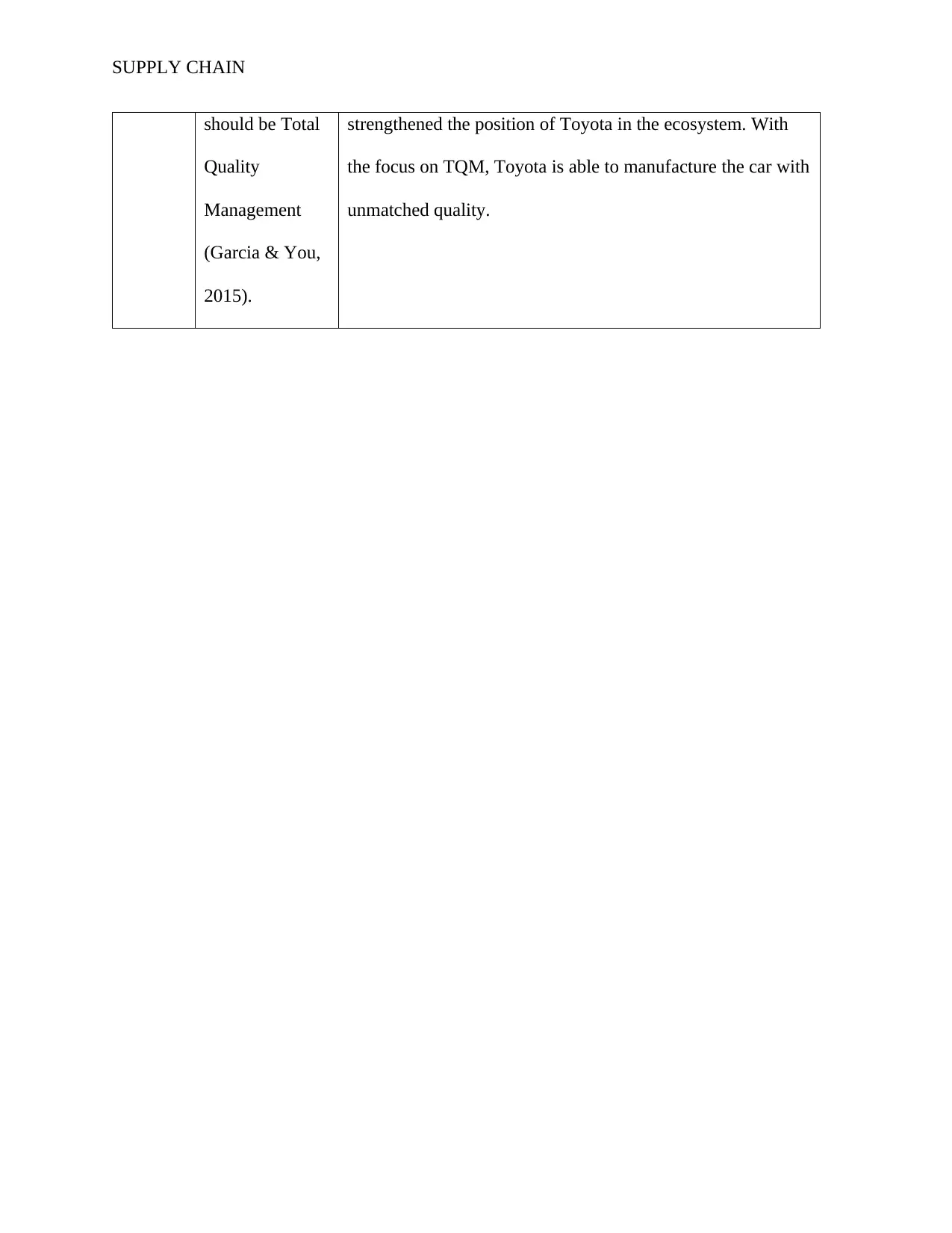
SUPPLY CHAIN
should be Total
Quality
Management
(Garcia & You,
2015).
strengthened the position of Toyota in the ecosystem. With
the focus on TQM, Toyota is able to manufacture the car with
unmatched quality.
should be Total
Quality
Management
(Garcia & You,
2015).
strengthened the position of Toyota in the ecosystem. With
the focus on TQM, Toyota is able to manufacture the car with
unmatched quality.
⊘ This is a preview!⊘
Do you want full access?
Subscribe today to unlock all pages.

Trusted by 1+ million students worldwide
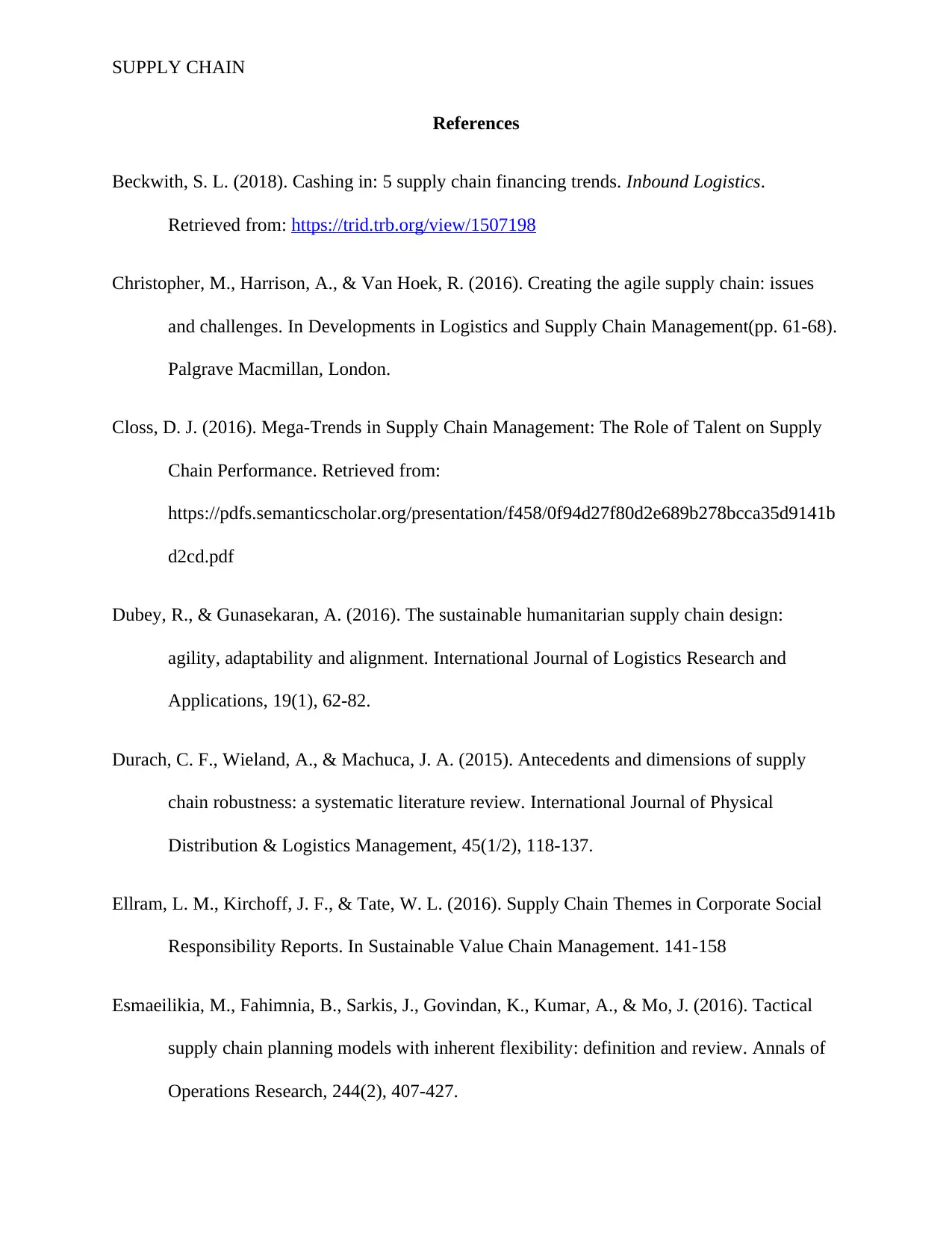
SUPPLY CHAIN
References
Beckwith, S. L. (2018). Cashing in: 5 supply chain financing trends. Inbound Logistics.
Retrieved from: https://trid.trb.org/view/1507198
Christopher, M., Harrison, A., & Van Hoek, R. (2016). Creating the agile supply chain: issues
and challenges. In Developments in Logistics and Supply Chain Management(pp. 61-68).
Palgrave Macmillan, London.
Closs, D. J. (2016). Mega-Trends in Supply Chain Management: The Role of Talent on Supply
Chain Performance. Retrieved from:
https://pdfs.semanticscholar.org/presentation/f458/0f94d27f80d2e689b278bcca35d9141b
d2cd.pdf
Dubey, R., & Gunasekaran, A. (2016). The sustainable humanitarian supply chain design:
agility, adaptability and alignment. International Journal of Logistics Research and
Applications, 19(1), 62-82.
Durach, C. F., Wieland, A., & Machuca, J. A. (2015). Antecedents and dimensions of supply
chain robustness: a systematic literature review. International Journal of Physical
Distribution & Logistics Management, 45(1/2), 118-137.
Ellram, L. M., Kirchoff, J. F., & Tate, W. L. (2016). Supply Chain Themes in Corporate Social
Responsibility Reports. In Sustainable Value Chain Management. 141-158
Esmaeilikia, M., Fahimnia, B., Sarkis, J., Govindan, K., Kumar, A., & Mo, J. (2016). Tactical
supply chain planning models with inherent flexibility: definition and review. Annals of
Operations Research, 244(2), 407-427.
References
Beckwith, S. L. (2018). Cashing in: 5 supply chain financing trends. Inbound Logistics.
Retrieved from: https://trid.trb.org/view/1507198
Christopher, M., Harrison, A., & Van Hoek, R. (2016). Creating the agile supply chain: issues
and challenges. In Developments in Logistics and Supply Chain Management(pp. 61-68).
Palgrave Macmillan, London.
Closs, D. J. (2016). Mega-Trends in Supply Chain Management: The Role of Talent on Supply
Chain Performance. Retrieved from:
https://pdfs.semanticscholar.org/presentation/f458/0f94d27f80d2e689b278bcca35d9141b
d2cd.pdf
Dubey, R., & Gunasekaran, A. (2016). The sustainable humanitarian supply chain design:
agility, adaptability and alignment. International Journal of Logistics Research and
Applications, 19(1), 62-82.
Durach, C. F., Wieland, A., & Machuca, J. A. (2015). Antecedents and dimensions of supply
chain robustness: a systematic literature review. International Journal of Physical
Distribution & Logistics Management, 45(1/2), 118-137.
Ellram, L. M., Kirchoff, J. F., & Tate, W. L. (2016). Supply Chain Themes in Corporate Social
Responsibility Reports. In Sustainable Value Chain Management. 141-158
Esmaeilikia, M., Fahimnia, B., Sarkis, J., Govindan, K., Kumar, A., & Mo, J. (2016). Tactical
supply chain planning models with inherent flexibility: definition and review. Annals of
Operations Research, 244(2), 407-427.
Paraphrase This Document
Need a fresh take? Get an instant paraphrase of this document with our AI Paraphraser
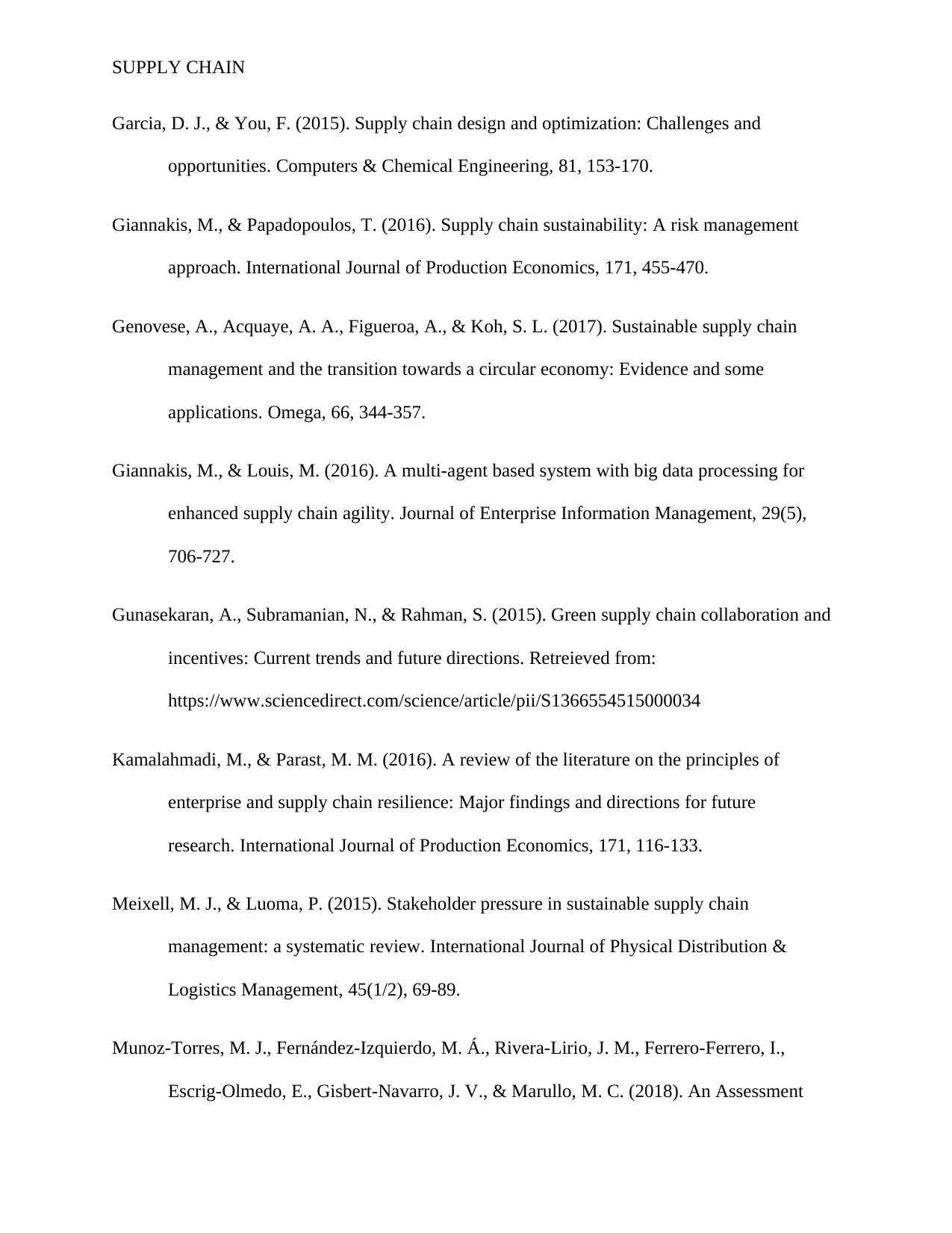
SUPPLY CHAIN
Garcia, D. J., & You, F. (2015). Supply chain design and optimization: Challenges and
opportunities. Computers & Chemical Engineering, 81, 153-170.
Giannakis, M., & Papadopoulos, T. (2016). Supply chain sustainability: A risk management
approach. International Journal of Production Economics, 171, 455-470.
Genovese, A., Acquaye, A. A., Figueroa, A., & Koh, S. L. (2017). Sustainable supply chain
management and the transition towards a circular economy: Evidence and some
applications. Omega, 66, 344-357.
Giannakis, M., & Louis, M. (2016). A multi-agent based system with big data processing for
enhanced supply chain agility. Journal of Enterprise Information Management, 29(5),
706-727.
Gunasekaran, A., Subramanian, N., & Rahman, S. (2015). Green supply chain collaboration and
incentives: Current trends and future directions. Retreieved from:
https://www.sciencedirect.com/science/article/pii/S1366554515000034
Kamalahmadi, M., & Parast, M. M. (2016). A review of the literature on the principles of
enterprise and supply chain resilience: Major findings and directions for future
research. International Journal of Production Economics, 171, 116-133.
Meixell, M. J., & Luoma, P. (2015). Stakeholder pressure in sustainable supply chain
management: a systematic review. International Journal of Physical Distribution &
Logistics Management, 45(1/2), 69-89.
Munoz-Torres, M. J., Fernández-Izquierdo, M. Á., Rivera-Lirio, J. M., Ferrero-Ferrero, I.,
Escrig-Olmedo, E., Gisbert-Navarro, J. V., & Marullo, M. C. (2018). An Assessment
Garcia, D. J., & You, F. (2015). Supply chain design and optimization: Challenges and
opportunities. Computers & Chemical Engineering, 81, 153-170.
Giannakis, M., & Papadopoulos, T. (2016). Supply chain sustainability: A risk management
approach. International Journal of Production Economics, 171, 455-470.
Genovese, A., Acquaye, A. A., Figueroa, A., & Koh, S. L. (2017). Sustainable supply chain
management and the transition towards a circular economy: Evidence and some
applications. Omega, 66, 344-357.
Giannakis, M., & Louis, M. (2016). A multi-agent based system with big data processing for
enhanced supply chain agility. Journal of Enterprise Information Management, 29(5),
706-727.
Gunasekaran, A., Subramanian, N., & Rahman, S. (2015). Green supply chain collaboration and
incentives: Current trends and future directions. Retreieved from:
https://www.sciencedirect.com/science/article/pii/S1366554515000034
Kamalahmadi, M., & Parast, M. M. (2016). A review of the literature on the principles of
enterprise and supply chain resilience: Major findings and directions for future
research. International Journal of Production Economics, 171, 116-133.
Meixell, M. J., & Luoma, P. (2015). Stakeholder pressure in sustainable supply chain
management: a systematic review. International Journal of Physical Distribution &
Logistics Management, 45(1/2), 69-89.
Munoz-Torres, M. J., Fernández-Izquierdo, M. Á., Rivera-Lirio, J. M., Ferrero-Ferrero, I.,
Escrig-Olmedo, E., Gisbert-Navarro, J. V., & Marullo, M. C. (2018). An Assessment
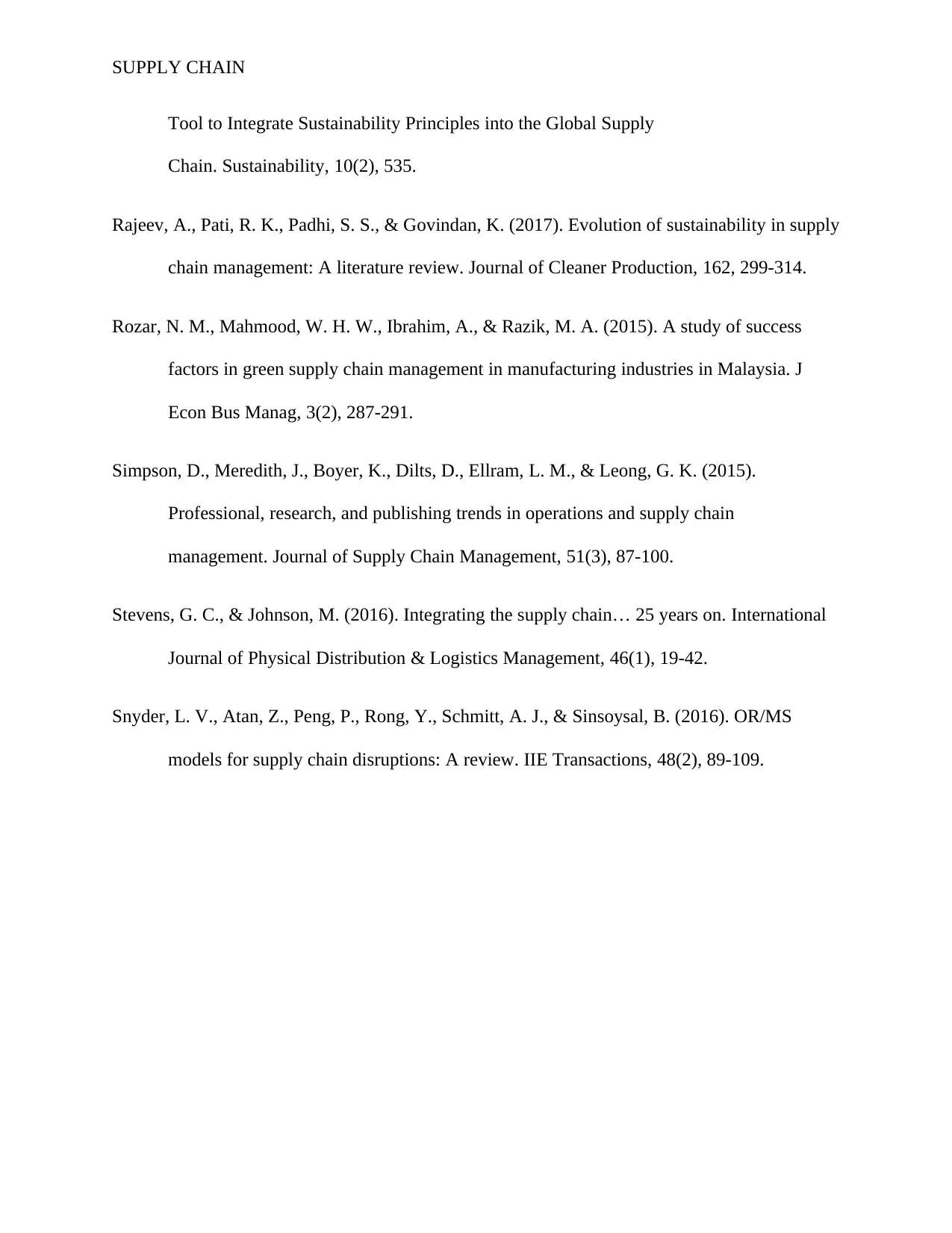
SUPPLY CHAIN
Tool to Integrate Sustainability Principles into the Global Supply
Chain. Sustainability, 10(2), 535.
Rajeev, A., Pati, R. K., Padhi, S. S., & Govindan, K. (2017). Evolution of sustainability in supply
chain management: A literature review. Journal of Cleaner Production, 162, 299-314.
Rozar, N. M., Mahmood, W. H. W., Ibrahim, A., & Razik, M. A. (2015). A study of success
factors in green supply chain management in manufacturing industries in Malaysia. J
Econ Bus Manag, 3(2), 287-291.
Simpson, D., Meredith, J., Boyer, K., Dilts, D., Ellram, L. M., & Leong, G. K. (2015).
Professional, research, and publishing trends in operations and supply chain
management. Journal of Supply Chain Management, 51(3), 87-100.
Stevens, G. C., & Johnson, M. (2016). Integrating the supply chain… 25 years on. International
Journal of Physical Distribution & Logistics Management, 46(1), 19-42.
Snyder, L. V., Atan, Z., Peng, P., Rong, Y., Schmitt, A. J., & Sinsoysal, B. (2016). OR/MS
models for supply chain disruptions: A review. IIE Transactions, 48(2), 89-109.
Tool to Integrate Sustainability Principles into the Global Supply
Chain. Sustainability, 10(2), 535.
Rajeev, A., Pati, R. K., Padhi, S. S., & Govindan, K. (2017). Evolution of sustainability in supply
chain management: A literature review. Journal of Cleaner Production, 162, 299-314.
Rozar, N. M., Mahmood, W. H. W., Ibrahim, A., & Razik, M. A. (2015). A study of success
factors in green supply chain management in manufacturing industries in Malaysia. J
Econ Bus Manag, 3(2), 287-291.
Simpson, D., Meredith, J., Boyer, K., Dilts, D., Ellram, L. M., & Leong, G. K. (2015).
Professional, research, and publishing trends in operations and supply chain
management. Journal of Supply Chain Management, 51(3), 87-100.
Stevens, G. C., & Johnson, M. (2016). Integrating the supply chain… 25 years on. International
Journal of Physical Distribution & Logistics Management, 46(1), 19-42.
Snyder, L. V., Atan, Z., Peng, P., Rong, Y., Schmitt, A. J., & Sinsoysal, B. (2016). OR/MS
models for supply chain disruptions: A review. IIE Transactions, 48(2), 89-109.
⊘ This is a preview!⊘
Do you want full access?
Subscribe today to unlock all pages.

Trusted by 1+ million students worldwide
1 out of 9
Related Documents
Your All-in-One AI-Powered Toolkit for Academic Success.
+13062052269
info@desklib.com
Available 24*7 on WhatsApp / Email
![[object Object]](/_next/static/media/star-bottom.7253800d.svg)
Unlock your academic potential
Copyright © 2020–2025 A2Z Services. All Rights Reserved. Developed and managed by ZUCOL.




